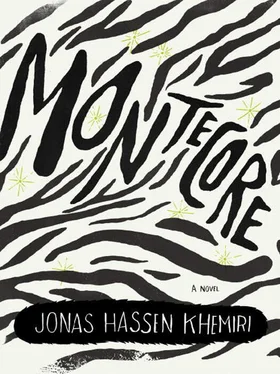“My dearest Pernilla. I love you above everything. We will survive this, together we will show them, we will never be conquered. NEVER!!!! We will dazzle your damned family, we will break their images, we will delight their forgiveness. They commit me as a political fundamentalist and you as a duped daughter. These are my whispering words; I think them now and let them be tattooed on my forehead as punishment if I fail: After my success your family will, crying, lap the sweat out of our sumptuously invested shoes. My mentality will be more Swedish than their imaginable ideal. My photographic success will be more illuminated than their goddamn Christmas trees. The assets of our economy will grow higher than their goddamn Kaknäs Tower. Let us start the countdown to the day when Khemiri creates a familyesque Swedish superclan with the influence of Bonniers and the finances of Rockefeller.”
Pernilla woke and whispered with diamondish eyelashes:
“But … We can’t forget the people’s fight.”
No one has been more lovable to me than that bizarre woman, Kadir. I solemnly auction that we are going to share our common futures for all of the future!
Our New Year celebration was sparkled with all of Pernilla’s friends in a big house in the Skarpnäck neighborhood. There were woodish parquet floors and monstrous multitudes of alcohol. Pernilla’s friends were warmly inviting to me, they smiled me kindly, requested my view on politics, and praised their repeated tributes about the book The Prophet by Khalil Gibran. At the countdown of the strike of twelve, Pernilla dragged me aside, she whispered me words that I can’t write you, and we shared heavenly kisses accompanied by the heavenly explosions of artificial fires. 2
In the dawning of the new year, Pernilla and I promenaded Stockholm’s hundreds of parks, lakes, and bridges. The snow softened itself down from the sky, the air smoked our mouths, and the chill was so cold that the interior hairs of one’s nose adhered themselves together when one breathed (an unusual but not uncomfortable emotion). The snow crunched our shoes, the sun was squintingly beautiful, and the water lay deeply iced. One day we observed the majority of children who threw their backs into the snow and kicked and twisted their bodies in wild spasms. Pernilla pointed the pattern of the snow and informed that they were making so-called angels. Then we mirrored each other’s eyes and without saying anything we said something — if you understand what I mean?
I am terminating here with hope for your soon response.
Abbas 3
Stockholm, April 15, 1978
Greetings, Kadir!
Thank your finely formulated letter and your particular specification of how my interest on the loan has expanded this first half year. My Swedish life has now found its everyday. Pernilla and I share our permanent company, a little like you and me in Tabarka. Together we manifest for the expanded power of women and choir our critique of nuclear power, capitalism, apartheid, and fur industry. Together we pass evenings at cinemas and wander toward the metro enjoying the smells of wakened spring: carefully sprouting leaves, the food odors of the hot dog men, my beloved’s lavender soap. Do you remember how I named Sweden as “the land of odor- and colorlessness?” This is no longer adequate. Spring in Sweden smells and lives, people are dormanting from their hibernation, they smile on the metro, and sometimes (but seldom) the neighbors return one’s greetings in the elevator. The warmth of spring modifies everything.
Parallel with Pernilla’s and my love progression I have devoted time to my photographic career. The premiere step was to localize an assistant job. I wandered my steps from studio to studio; I presented my portfolio from Tabarka and offered myself at a reduced or almost free cost. My success was not particularly abrupt. Frequent were the photographers who detailed that they unfortunately could not assist an assistant who does not cultivate the Swedish language. My arguments that the world of images does not automatically require linguistic exactness were ignored.
Luckily enough, one of Pernilla’s colleagues has introduced me to a Swedish-Finnish photographer by the name Raino. Raino is specialized in the delicate art that we call food photography. His eyelashes shine like white mammals above his reddened nose. His mustache is of yellowed walrus model and his drinking habits are unmoderate. The studio is very modern in comparison with Achraf’s primitive utensils, however. It is localized in the luxurious neighborhood of Flemingsberg, near Stockholm. I pass circa twenty hours per week in service to Raino, developing potatoes au gratin, warmly steaming Falukorv, and delicious pâtés. I am learning many special tricks. For example, do you know how one photographs the most delicate portrait of a cup of coffee? One fills the cup with soy sauce mixed with a few foaming drops of dish soap. Consequently one escapes the uglifying surface coating! Methods like these reinflate my fascination with the magic of photography. Which other expression has such a privileged relation to reality that it can grow one’s appetite for coffee at the sight of a cup of soy sauce?
When the customers of photo tasks are limited, I assist Raino with other services. 4
The position with Raino strengthens my routine, but the economy offered me is nonexistent. The weight of the worth lies in the chance to be able to polish my own projects. Let me take the opportunity here to repeat my thankfulness for your generously delegated economy. Thanks to your loan my arrival in Sweden has not been honorless; I have not had to profit from Pernilla’s finances, and in addition I have invested myself a new system camera.
The multitude of motifs in this country is monstrously many to me. In every neighborhood, at every metro station, through every window it seems to me motifs lie brooding, awaiting their documentation. Sometimes it experiences me as inspiring, sometimes as stressful. 5
Today the spring was invited to Stockholm. The sun shone in the typical Swedish way; it dazzled one’s eyes without offering more than the superficial warmth of the skin. Pernilla was at work, Raino had liberated me early, and I wandered my solitary steps through central Stockholm. Soon I parked my body on a bench in a park that in Swedish is given the name Humlans Gård. On the opposite side of the street was localized a sunshined corner; birds chirped, and everything was maximized harmony. Then I suddenly noticed a man who was swinging his briefcase, flapping his skinny tie, stressing his clomping steps, and glancing his wrist …
“A typical office drone,” I thought. “Run farther, you poor slave, while we artists delight sunshine on parkish benches.”
Then something bizarre occurred. When he turned around the corner of the neighborhood and collided with the sunlight, he was hypnotized into stillness. He stopped his steps in slow motion, localized his body to the vicinity of the wall, stretched his neck like an odor-searching dog, closed his eyes, and then … he just stood there. Like a statue. And enjoyed with a heavenly expression, which of course I documented with my camera. The interesting thing was that he was not solitary in his behavior. ALL of Stockholm was filled with compatible patterns this first spring day; in EVERY sunshined neighborhood, at every bus stop, on every square they stood, suddenly placed out, all the neatly dressed office Swedes with the same backward-tilting head, delighting mouth, and closed eyes. Hundreds of people who sought the first blessing of light like thirsting plants. Often accompanied by a noise trickling from their lips that is best described like this: Mmmm. My camera documented this bizarre behavior and my plan is to name my premier collection Stockholm: Sunnish Corners and Wintry Bicycles . It will probably be ready in the summer. 6
Читать дальше










